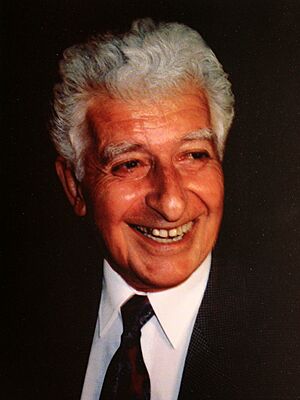Edvard Mirzoyan facts for kids
Edvard Mik'aeli Mirzoyan (born May 12, 1921 – died October 5, 2012) was a famous Armenian composer. He was born in Gori, Georgia. Mirzoyan believed that life itself was a miracle, finding wonder in every small detail of nature.
He was part of a special group of composers sometimes called "Armenia's Mighty Handful." This name reminds people of a famous group of Russian composers from the 1800s. Edvard Mirzoyan was also a key part of the "Armenian School" of music. Other important composers in this group were Arno Babajanian and Alexander Arutiunian.
His Life Story
Mirzoyan started his music journey at the Yerevan Music School, named after A. Spendiarov. He later graduated from the Komitas State Conservatory in 1941. There, he studied with Armenian composers Sargis Barkhudaryan and Vardges Talyan. His graduation project was a symphonic poem called “Loretsi Sako.” In 1942, he joined the Red Army. During his time there, he wrote many songs about patriotism and war.
In 1948, Mirzoyan became a professor at the Yerevan Conservatory. He later became the head of the composition department in 1965. From 1952, he also taught at the R. O. Melikyan Musical College. This school is now known as the Yerevan State Musical College, named after Romanos Melikyan.
In the late 1950s, he was chosen to be the president of the Armenian Composers’ Union. He held this important job until 1991. He also led the Peace Foundation of Armenia. While he was president of the Composers' Union, Mirzoyan helped build a special resort for composers in Dilijan. This resort is now named after him. It became one of the most famous cultural places in the Soviet Union.
His Family
Edvard Mirzoyan's father was Colonial Semyon Alikhanov, and his mother was Lusya B. Pershangova. His mother was an actress at the Sundukyan Theater. She also trained in classical singing at the Yerevan Conservatory.
Edvard Mirzoyan was married to Elena (Heghine) Mamikonovna for 50 years. He had two children, Zara and Arshak Mirzoyan.
His Amazing Music
Edvard Mirzoyan didn't write a huge amount of music, but what he did write was very special. His music often combined beautiful, flowing melodies with strong, dramatic parts. His style is sometimes called Neoclassical. This means it had clear structures and traditional harmony, but with a modern touch. You can always hear elements of Armenian folk songs in his work.
Some of his most famous pieces include his String Quartet, Cello Sonata, Symphony for Strings and Timpani, and Epitaph for String Orchestra. These pieces are now important parts of classical music.
Edvard Mirzoyan passed away on October 5, 2012. He is buried at the Komitas Pantheon. This special cemetery is located in the center of Yerevan.
Music for Movies
Edvard Mirzoyan also composed music for several films. Here are some of the movies he worked on:
- Yot hndik tghaner (Seven Indian Boys, 2007)
- Khachmeruki deghatune (Crossroad's pharmacy, 1988)
- Tasnerku ughekitsner (Twelve Companions, 1962)
- Pluzum (Collapse, 1960)
- Chaos (Chaos, 1973)




